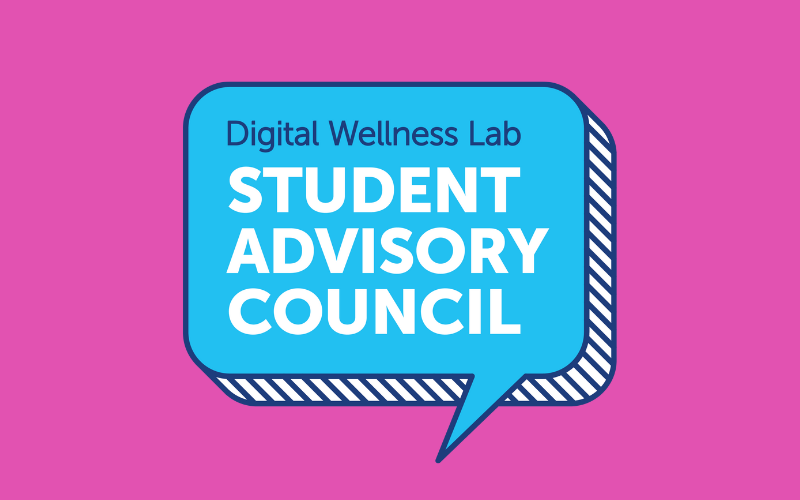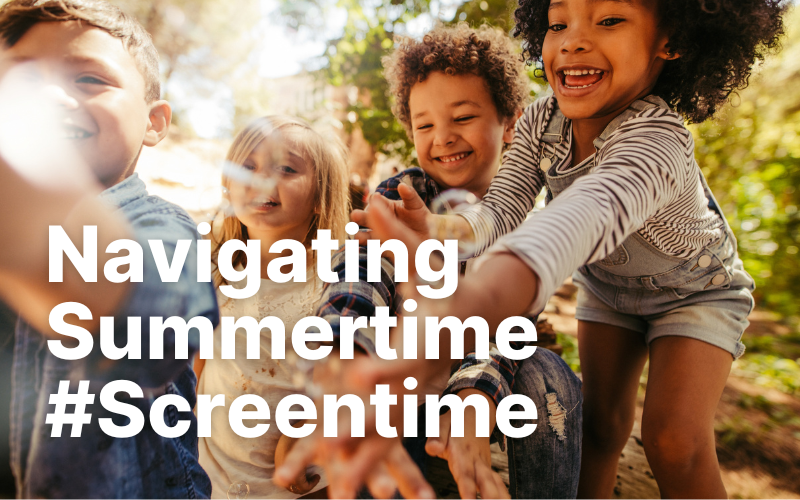With longer days and a break from school routines, it’s easy for kids to gravitate towards screens for entertainment. While digital media can offer educational and recreational benefits, balancing screen time with other activities (including sleep) is crucial for developing and maintaining physical, mental, and social-emotional health. In this post, we explore best practices for parenting around screen use, delve into the benefits of boredom, and provide age-appropriate tips to help you guide your child towards a healthy, balanced relationship with screens this summer and all year long.
Bring back boredom
Our cultural aversion to boredom is perhaps the most difficult challenge to overcome in finding healthy alternatives to screens. Adults and children alike evade boredom by having screens available to us virtually all our waking hours. But research indicates that boredom can be a catalyst for creativity, problem-solving, and self-discovery (Mann & Cadman, 2014). When children are bored, they are more likely to engage in creative play, explore new interests, and develop independence. Benefits of boredom include:
Creativity boost: Without constant stimulation, children and teens are more likely to create their own entertainment, leading to imaginative play.
Problem-solving skills: Boredom pushes kids to find solutions to their own problems, enhancing their critical thinking abilities.
Self-discovery: Time without structured activities allows children and teens to explore their interests and passions independently.
Mental resilience: Learning to cope with boredom helps children and teens develop patience and emotional regulation.
Ultimately, boredom is where ideas bubble up, creativity expands, and innovation thrives because it provides an uncomfortable vacuum, nudging us to fill it with new ideas, images, and sounds. So this summer, when your child tells you they’re bored, resist the urge to hand over a screen or give up on your family screen time agreement. You can be confident in the knowledge that boredom will help, not hurt, them — no matter how loudly they protest.
Avoid relying on screen time limits and bans
Our reality today is that screens are an integral part of all of our daily lives, kids included. From educational and coordination tools to entertainment and social interaction, screens serve multiple functions that can enhance learning and connectivity (Canadian Paediatric Society, 2019; Carter et al., 2020). Moreover, screens provide access to a wealth of information and resources that can support children’s intellectual and emotional development. While there is certainly such a thing as problematic usage of digital media and technology (see our Family Guide to Problematic Interactive Media Use), thinking about managing digital media use solely in terms of time limits or bans is impractical and potentially counterproductive.
Instead, we should be focusing on how to help our kids develop a healthy relationship with technology and media. Research suggests that supporting children’s autonomy and teaching them how to use media in positive ways is more effective than imposing screen time limits or banning content altogether (Meeus et al., 2019; Padilla-Walker et al., 2020). When children are educated about tech and media use and engaged in discussions about content quality and navigating the online world responsibly, they are better able to self-regulate their own use, resulting in:
- Improved critical thinking skills
- A more discerning approach to media consumption
- A healthier relationship with technology
Moreover, focusing on teaching, rather than simply rule-setting, empowers children to make informed choices, recognize and avoid harmful content, and use technology in ways that enhance their learning and wellbeing. By equipping children with the tools to navigate the digital landscape responsibly, caregivers can foster lifelong skills that extend beyond kids just “following the rules,” promoting a more sustainable and positive engagement with the tech they use.
Choose a mutual understanding over mandates
One of the most effective ways to help your child build a healthy relationship with technology and digital media is to talk with them, not at them, about their screen use. Taking a collaborative approach will go a lot further in setting boundaries, establishing expectations, and creating a shared understanding, similar to other areas of parenting.
Why collaboration matters
When kids are meaningfully involved in setting screen agreements, they are more likely to understand and respect the boundaries – young people often understand why rules are necessary to help them develop healthy media habits, and even want parental support (Ko et al., 2015; Moreno et al., 2019). This process fosters a sense of responsibility and ownership, making them more invested in following the guidelines. Collaborative discussions also provide an opportunity to address any concerns or questions your child might have, leading to smoother family interactions.
Steps to building a shared understanding
- Open communication: Start by discussing the importance of balanced screen use with your child. Explain why certain rules are required and how they benefit everyone.
- Set clear boundaries together: Involve your child in setting screen rules. This could include deciding on specific times of day for screen use, agreeing on a maximum daily screen time (especially during the summer months, on weekends, and vacations), and deciding what types of content are allowed.
- Establish consequences: Agree on reasonable consequences for not meeting jointly agreed-upon expectations. Ensure that these consequences are fair and consistently enforced.
- Encourage input: Ask for your child’s input on what activities they enjoy and how they might balance these with screen time, and share in their enthusiasm for their offline hobbies and interests.
- Review and adjust: Periodically review the screen time rules and make adjustments as needed. This ensures that the guidelines remain relevant and effective as your child grows, and their needs change.
- Set a good example: Demonstrate balanced screen use in your own life and consider adding your own screen use to the agreement you reach with your child. Children are more likely to follow the rules if they see their caregivers engaging in similar practices.
Help your child succeed
We believe in tailoring “shared media use agreements” to optimally support your child’s success at every age and stage. You know your child best. If they respond to rewards like gold stars, use a chart on the fridge. If they are motivated by praise and encouragement, focus on that. If they need daily reminders, try post-it notes or text messages. Customizing your approach to fit your child’s unique needs and motivations will lead to the best outcomes — healthy and balanced media use for your child, and less frustration and worry for you.
Tips for Healthy Screen Use by Age
Infants & Toddlers (Ages 0-2)
At this stage, children learn best through hands-on activities and face-to-face interactions. Recognizing that some screen time is unavoidable in today’s digitally-saturated world, ultimately, screens should play a limited role in the daily activities of infants and toddlers.
Limit screen time: This is the stage when screen time limits are appropriate to support your child’s development. The American Academy of Pediatrics (AAP) recommends avoiding digital media use (except video chatting with family and friends which can be made even more valuable by sharing experiences across the chat, like “sharing” a snack) as much as possible for children younger than 18 months (Piper et al., 2023). When screen time is necessary, for example to provide the parent with a few minutes to complete a task, use it sparingly and focus on calm, developmentally-appropriate content. For children aged 18 to 24 months, choose high-quality programming and, when possible, watch it with them and chat about the content to help them understand what they’re seeing.
Encourage interactive play: Engage your child in activities that involve physical movement, sensory play, and interaction with caregivers. This can include reading books, playing with toys, and exploring the outdoors. You can also help your child tune their senses by involving them in your activities. For younger children, try putting them in their bouncy seat in the bathroom while you’re taking a shower, or set them up with a spoon and bowl while you make dinner.
Teach your child to self-soothe: Read, rock, and play music before they go to sleep, but then turn everything off (besides any “white noise” you may use) and let them fall asleep on their own.
Preschoolers (Ages 3-5)
While screens can play a role in educating, entertaining, and offering caregivers a much-needed break, children at this stage benefit most from hands-on, interactive activities.
Set clear limits: The American Academy of Pediatrics (AAP) recommends no more than one hour of high-quality programming per day for children aged 2 to 5. Realizing that this may not be realistic for many caregivers, make sure to choose high-quality interactive — versus passive — content. Keep an eye on your child, and switch to another activity when they appear to be losing interest.
Co-view and discuss: Watch shows or play age-appropriate video games with your child, and engage with them about what they’re watching to enhance their understanding and learning. You can ask questions about what they are seeing on the screen, share observations, ask about decisions they’re making in a game, and discuss hypotheticals based on the on-screen situations.
Encourage active play: Prioritize physical activities like outdoor play, arts and crafts, and hands-on toys and games over screen time whenever possible.
Grade Schoolers & Tweens (Ages 6-12)
At this stage, children are becoming more independent but still require guidance to ensure balanced screen use.
Create a schedule: During the summer months without the structure of school year commitments and activities, establish a daily routine that includes ample time for outdoor play and exercise, reading, and family activities along with the screen use that you as a family has decided is appropriate.
Prioritize educational content: Encourage the use of educational apps and programs that promote learning and creativity. Apps that help children to learn a new language, compose music, draw or animate, or read books and high-quality newspapers can support their ongoing development even while using the internet.
Consider waiting to provide a cell phone: Reduce the pressures and potential negative impacts of early smartphone use by banding together with other families in your child’s school and/or friend groups to support the decision to not provide a smartphone until at least the end of the 8th grade. This enables children to develop their critical thinking, self-regulation, and social skills before they need to take these competencies into the online world. Flip phones can provide basic call and texting to enable children to stay in touch without the complexities of interactive media and other online distractions.
Teenagers (Ages 13-18)
For teenagers, encourage responsible and mindful screen use.
Promote balance: Encourage teens to balance screen time with physical activity, social interactions, and hobbies. Support their development of an intentional approach to when they choose to use screens — what are they seeking to achieve, how do they want to feel, and what are they not doing in order to use the screen?
Model healthy habits: Lead by example by practicing good screen habits yourself, such as taking regular breaks and prioritizing face-to-face communication. Put down your own devices when your child is speaking to you and talk about your own intentional choices when using screen time.
Create space for open dialogue: Try not to judge, and maintain open communication about online safety, digital footprints, and the potential impact of social media on mental health. Be open to hearing about your child’s experiences online, even if you don’t completely understand why they enjoy them!
Practical tips for implementation
Practice the 5 M’s of Digital Wellness: To teach your child how to use their devices in a positive, intentional, and healthy way, we have developed the 5 M’s of Digital Wellness: Model, Mentor, Monitor, Mastery, and Meaning. Learn more here.
Positive reinforcement: Positive reinforcement can motivate continued healthy behavior — praise and reward your child for following screen rules and engaging in non-screen activities.
Family meetings: Hold regular discussions about screen use and any adjustments needed. Encourage your children to hold you accountable as well. This keeps everyone on the same page and promotes a team approach.
Designate screen-free zones: Establish screen-free zones, especially in bedrooms and during meal times, to promote better sleep and family bonding. If possible, turn off background media to decrease visual and auditory distraction and let your children hear the ambient sounds of home, nature, and street life — helping them learn to enjoy quiet.
Embrace a digitally balanced summer
Summertime offers a unique opportunity for children to explore new interests, develop creativity, and enjoy unstructured time. With thoughtful strategies, you can help your child develop an authentic, intentional, and balanced relationship with technology even without the structures of the school year.
- Collaborate with your child to foster understanding and respect for boundaries, building a sense of responsibility.
- Focus on media literacy and encourage responsible technology use to empower your child to make informed choices.
- Promote healthy media use by tailoring agreements to suit your child’s unique needs and motivations.
- Allow and even encourage your kids’ boredom to support creativity, problem-solving, and self-discovery.
Taking these steps will help to ensure that screens are a valuable tool, rather than a distraction, during your child’s summer experience.For more information about helping your child build healthy screen habits, check out our 2023-24 Family Digital Wellness Guide, now available in English and Spanish.







